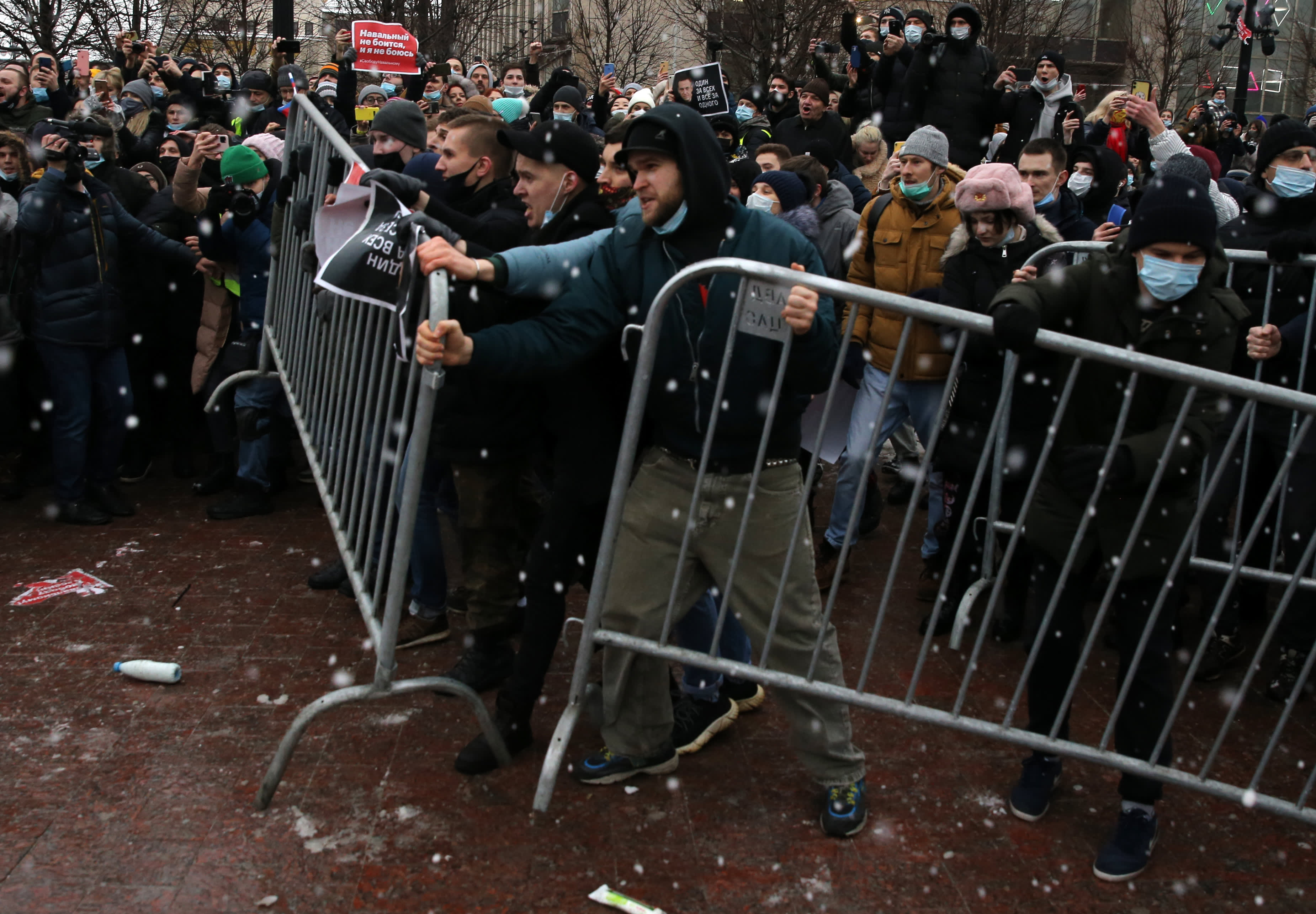
Participants of an unauthorized protest rally against of jailing of oppositon leader Alexei Navalny clash with police, on January 23, 2021 in Moscow, Russia.
Mikhail Svetlov | Getty Images News | Getty Images
Russia saw widespread protests against President Vladimir Putin at the weekend, with demonstrations involving tens of thousands of people and taking place in as many as 100 cities.
Experts say the protests, mainly in support of arrested opposition leader Alexei Navalny but also attracting members of the public angry at corruption and injustices in Russia, could be more significant than previous unrest.
“It’s tempting here to take the Kremlin narrative that these (protests) were relatively small scale and are not backed by the wider population — hence will go nowhere,” Timothy Ash, a senior emerging markets strategist at Bluebay Asset Management, said on Monday.
“Indeed, there have been similar protests back in 2011, in 2015 following the murder of Boris Nemtsov, and in 2019 — which all went nowhere … But something feels different this time around,” he added.
Here’s CNBC’s guide to what’s going on in Russia and why it matters.
What’s going on?
Protests took place across Russia on Saturday, and were principally in support of arrested opposition leader Navalny, a prominent anti-corruption campaigner and critic of Putin.
In Moscow, at least 40,000 people were estimated to have participated in an unauthorized rally.
Participants of an unauthorized protest rally against of jailing of oppositon leader Alexei Navalny shout, on January 23, 2021 in Moscow, Russia. E
Mikhail Svetlov | Getty Images News | Getty Images
“More than 40% of attendees were first time protesters, and demonstrations occurred in over 100 cities, including places like Sevastopol and Kemerovo, where overt anti-government activity is rare,” Daragh McDowell, head of Europe and principal Russia analyst at Verisk Maplecroft, said.
Police reportedly detained more than 2,500 people in the Russian capital.
Why did protests take place?
Navalny’s detention, and an investigation into a Black Sea residence that has been dubbed “Putin’s Palace” by Navalny’s organization, are the main factors behind the protest.
Navalny was detained on Jan. 17 immediately upon his return to Russia from Germany, where he had been treated following nerve agent poisoning last August. Putin was accused of being behind the poisoning; the Kremlin denies any involvement.
Russian opposition leader Alexei Navalny and his wife Yulia are seen in a Pobeda plane after it landed at Moscow’s Sheremetyevo airport on January 17, 2021.
KIRILL KUDRYAVTSEV | AFP | Getty Images
Navalny was accused of parole violations, but accuses the state of creating trumped-up charges against him.
What is the ‘Putin’s Palace’ video?
Since Navalny’s arrest, tensions have risen further after his team released a video in which it alleged that Putin had a luxurious palace built on Russia’s Black Sea at a cost of $1.37 billion, and allegedly financed by associates of Putin and what they claimed was “the biggest bribe in history.”
Putin has refuted the allegations, saying on Monday that the palace does not belong to him or his family, Reuters reported. He also said that the film was a “brain wash” and “boring.”
Still, the video has been viewed more than 87 million times on YouTube, giving allegations against Putin mass exposure, and potentially embarrassing Russia’s strongman leader at a time when millions of ordinary Russians are struggling with the coronavirus crisis and its impact on the economy.
A woman watches an investigation into “Putin’s Palace” by Russian opposition leader Alexei Navalny in Moscow on January 21, 2021.
ALEXANDER NEMENOV | AFP | Getty Images
Navalny’s team said he had recorded the video before his return to Russia but had immediately released it on his detention, as they called on the public to join protests on Saturday afternoon.
“Alexei is always fighting for our rights, and now we must fight for him. Vladimir Putin is obliged to answer for all his crimes,” his team said on YouTube.
Why do the protests matter?
Experts say the protests are significant, and are a pain for the Kremlin. “The protests were not huge – perhaps 40K (people) in Moscow — but they were very widespread with protests in 50-plus cities,” Bluebay Asset Management’s Ash noted.
“And remember that the turnout was against the background of widespread intimidation — arrest of opposition leaders, warnings to students they will be kicked out of schools and college, plus restrictions in social media and the internet, and very cold weather.”
He added that online social media videos seemed to suggest broader support for protestors, “with cars honking horns in support and passers by critical of police brutality.”
What comes next?
The protests pose a challenge for the authorities, Verisk Maplecroft’s McDowell noted.
“The images of open clashes between the crowd and the police will be a double-edged sword for the authorities. On the one hand, it makes it easier to cast the demonstrators as violent hooligans, but on the other it demonstrates the coercive power of the state is not as formidable as the Kremlin would like to portray,” he said.
Whether the protests can maintain their momentum will be key to their impact, he added. “The opposition will now seek to organise follow-up rallies and other protests to keep up the pressure on the authorities. If they fail, the 23 January protests will go down as a flash in the pan, with minimal long-term political significance.”
“However, if the opposition can maintain momentum, particularly among younger, first time protesters they will pose a longer-term threat to Putin’s hold on power, which in part rests on his reputation as a guarantor of ‘stability’.”




